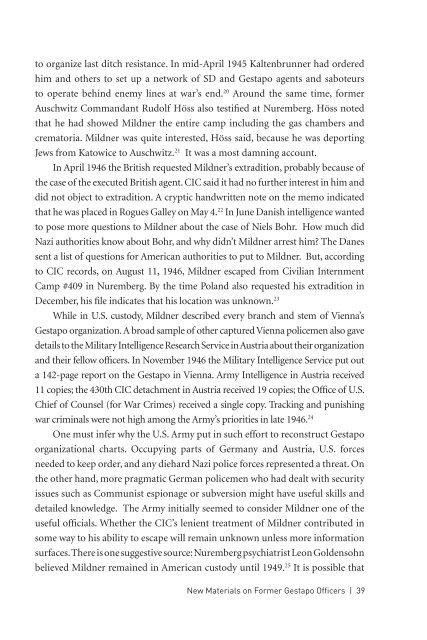hitlers-shadow
hitlers-shadow
hitlers-shadow
Create successful ePaper yourself
Turn your PDF publications into a flip-book with our unique Google optimized e-Paper software.
to organize last ditch resistance. In mid-April 1945 Kaltenbrunner had ordered<br />
him and others to set up a network of SD and Gestapo agents and saboteurs<br />
to operate behind enemy lines at war’s end. 20 Around the same time, former<br />
Auschwitz Commandant Rudolf Höss also testified at Nuremberg. Höss noted<br />
that he had showed Mildner the entire camp including the gas chambers and<br />
crematoria. Mildner was quite interested, Höss said, because he was deporting<br />
Jews from Katowice to Auschwitz. 21 It was a most damning account.<br />
In April 1946 the British requested Mildner’s extradition, probably because of<br />
the case of the executed British agent. CIC said it had no further interest in him and<br />
did not object to extradition. A cryptic handwritten note on the memo indicated<br />
that he was placed in Rogues Galley on May 4. 22 In June Danish intelligence wanted<br />
to pose more questions to Mildner about the case of Niels Bohr. How much did<br />
Nazi authorities know about Bohr, and why didn’t Mildner arrest him? The Danes<br />
sent a list of questions for American authorities to put to Mildner. But, according<br />
to CIC records, on August 11, 1946, Mildner escaped from Civilian Internment<br />
Camp #409 in Nuremberg. By the time Poland also requested his extradition in<br />
December, his file indicates that his location was unknown. 23<br />
While in U.S. custody, Mildner described every branch and stem of Vienna’s<br />
Gestapo organization. A broad sample of other captured Vienna policemen also gave<br />
details to the Military Intelligence Research Service in Austria about their organization<br />
and their fellow officers. In November 1946 the Military Intelligence Service put out<br />
a 142-page report on the Gestapo in Vienna. Army Intelligence in Austria received<br />
11 copies; the 430th CIC detachment in Austria received 19 copies; the Office of U.S.<br />
Chief of Counsel (for War Crimes) received a single copy. Tracking and punishing<br />
war criminals were not high among the Army’s priorities in late 1946. 24<br />
One must infer why the U.S. Army put in such effort to reconstruct Gestapo<br />
organizational charts. Occupying parts of Germany and Austria, U.S. forces<br />
needed to keep order, and any diehard Nazi police forces represented a threat. On<br />
the other hand, more pragmatic German policemen who had dealt with security<br />
issues such as Communist espionage or subversion might have useful skills and<br />
detailed knowledge. The Army initially seemed to consider Mildner one of the<br />
useful officials. Whether the CIC’s lenient treatment of Mildner contributed in<br />
some way to his ability to escape will remain unknown unless more information<br />
surfaces. There is one suggestive source: Nuremberg psychiatrist Leon Goldensohn<br />
believed Mildner remained in American custody until 1949. 25 It is possible that<br />
New Materials on Former Gestapo Officers | 39


